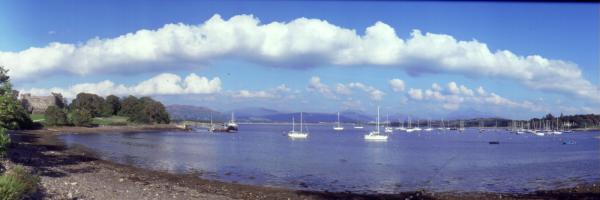 | MacAlpines on the Net Clan MacAlpine Discussion Area Clan MacAlpine Contacts |
 | MacAlpines on the Net Clan MacAlpine Discussion Area Clan MacAlpine Contacts |
Kenneth MacAlpin became the first King of Scotland in AD 843 when he united the Scots and the Picts. He was the son of King Alpin and the descendant of a long line of Dalriadic Kings. His direct male descendants ruled Scotland for the next 200 years and every Sovereign of Scotland since, including Queen Elizabeth, today, has had his Royal blood coursing through their veins. It is from him that our Clan takes its name, and, thus, he is considered our first Chief. Of course, as King he was Chief of Chiefs and this is reflected in the name of our Society newsletter. But, certainly, he was the Chief of his own family branch, his “Clan.” From King Alpin and King Kenneth, several powerful branches emerged, eventually becoming formidable Clans in their own right. This group or family of related clans, of which Clan MacAlpine is certainly a part, is known as Siol Alpine.
The history of Clan MacAlpine is shrouded in Scotland's distant past and is debated by scholars. We argue that the most likely chain of events is that one of King Kenneth’s chieftains, another descendant of King Alpin, was the next Chief, followed by alternating Alpin descendants, including some descended through King Kenneth. But, never again would the offices of Clan Chief and King of Scotland be held simultaneously. King Kenneth undoubtedly brought many of his family advisors and clansmen with him when he moved his capital from Argyllshire, the traditional seat of the Clan, to Scone, in Perthshire, leaving behind others to look after his interests in Argyll. Thus was created the Chiefship of Clan MacAlpine separate from the Kingship of Scotland. The Clan seat in Argyll became an outpost on the old frontier of a New Kingdom. What happened thereafter is unclear.
 Held Anciently |
Or, perhaps disenfranchised potential successors were sent to Argyll by the sitting King to keep them at a safe distance, busy defending against Viking raiders with little support from the Palace in Scone, in an attempt to minimize threats from his competitors. The position of Chief of the Clan MacAlpine seat in Argyll may have come to be known as an undesirable assignment. As such, the powers in Scone may have viewed the Clan’s holdings there merely as a source from which to repay local clan Chiefs for political favors. With the lands exhausted and the Chiefship unwanted, the MacAlpine clansmen and their families would have had no choice but to offer allegiance to other local clan Chiefs.
 is located on lands held Anciently by Clan MacAlpine |
Whatever the actual use of the old Clan seat, it seems clear that with the move of the capital to Scone, the stage was set for the ultimate breakdown of the Clan. As time went on, power shifted and the Clan lost its members to other, sometimes related, more powerful clans, ultimately becoming landless with no recognized Chief. This condition has persisted for the past five hundred years, or more. As a result, for all those hundreds of years, and still today, we have no hereditary Chief to whom we can give our allegiance or who speaks on our behalf.
But, now, we have the Society's President who presents our claims and calls us to unite. No longer will our Clan go undirected and unattended. Under the leadership of Kenneth James McAlpine, the Clan has united, once again, into an effective body. Today, MacAlpines can be found in all corners of the globe. The Clan, united through the Clan MacAlpine Society, is once again providing kinship for its clansmen and clanswomen. We hope that in the months to come, we will move closer to obtaining official recognition of the Clan and its leaders, however, this is secondary to our goals of promoting kinship among our members and preserving the Clan’s history. So, let the proud story of our Royal Clan be told and, let it now continue to grow as the Clan is, once again, united.
The following is a collection of some of what now makes up the written history of Clan MacAlpine: Writings of experts and old Gaelic sayings. We present them so that you gain an understanding of just how deeply these legends permeate Scottish history, remembering that most legends are based on fact. We put forth the question: Why have so many knowledgeable people written so much about a Clan some say never existed? We think that those who make such statements are short-sighted in their view of Scottish history, have ulterior motives, or speak boldly from the comfort of several hundred years away from the time of the actual events. We suggest that, had these individuals presented themselves in the Palace of King Kenneth MacAlpin and proclaimed that no Clan MacAlpine existed, they would have learned the lesson of its existence, in no uncertain terms, through their own swift death. Of course, that is presuming they would have had the courage to make such statements in his presence.
In his book, “The Scottish Tartans,” Sir Thomas Innes of Learney, Lord Lyon King of Arms, refers to the claim that this Royal Clan is the most ancient in the Highlands. He states that the Clan MacAlpine is Celtic and that records indicate that, for 25 generations, the Kings of Scotland were of MacAlpine lineage. He also states that the ancient crest was a boar’s head, the war cry being “Cumbrich Bas Ailpein" or, "Remember the death of Alpin,” and that the traditional home of the MacAlpines was Dunstaffnage, near Oban, Argyll. This former Lord Lyon is one of the most respected Lyons to serve Her Majesty and, therefore, his description of the Clan, its history, and its symbols is considered to be authoritative.
There is an old Gaelic saying: “Cnuic `is uillt `is Ailpeinich” (“Hills and Streams and MacAlpine”, which signifies the origin of the MacAlpines was contemporary with the origin of the hills and streams, that is, the earth.)
“Tradition claims MacAlpin or MacAlpine as the oldest and most purely Celtic of the Highland Clans, of royal descent from the dynasty of Kenneth MacAlpin who united the Picts and Scots into one kingdom from the year 850, and transferred his capital to Perthshire from Dunn Add in Dalriada (beside Loch Crinan.)” (From “Scots Kith & Kin,” page 49.)
MacAlpine: One of the chief branches of the royal clan Alpin. Their seat is said to have been at Dunstaffnage in Argyll though they are now landless and without a recognized Chief.
Siol Alpine is a name given to a group of clans that claim descent from Kenneth MacAlpin. They are the Grants, the MacAulays, the MacDuffs, the MacFies, the MacGregors, the MacKinnons, the MacNabs and the MacQuarries.
Regarding the name MacAlpine, one of the earliest records of an early form of the name appears when John MacAlpyne witnessed a charter by Malise, earl of Stratherne, of the lands of Cultenacloche and others in Glenalmond, c. 1260 (Grandtully, I, p. 126.) Monaghe fiz Alpyn of the county of Perth rendered forced homage to Edward I of England in 1296. (From "The Surnames of Scotland" by George F. Black.)

This information is Copyright 1999-2000 Clan MacAlpine Society. All Rights Reserved. Used with permission. Visit their site at http://www.macalpineclan.com/.
Panoramic photo of Dunstaffnage Castle Copyright © Donald Buchanan , Scottish Panoramic. Used with permission.






